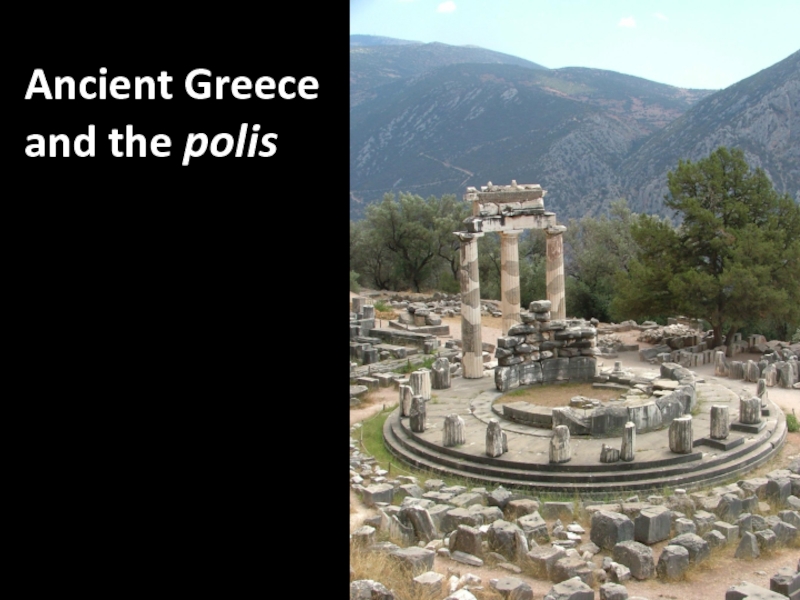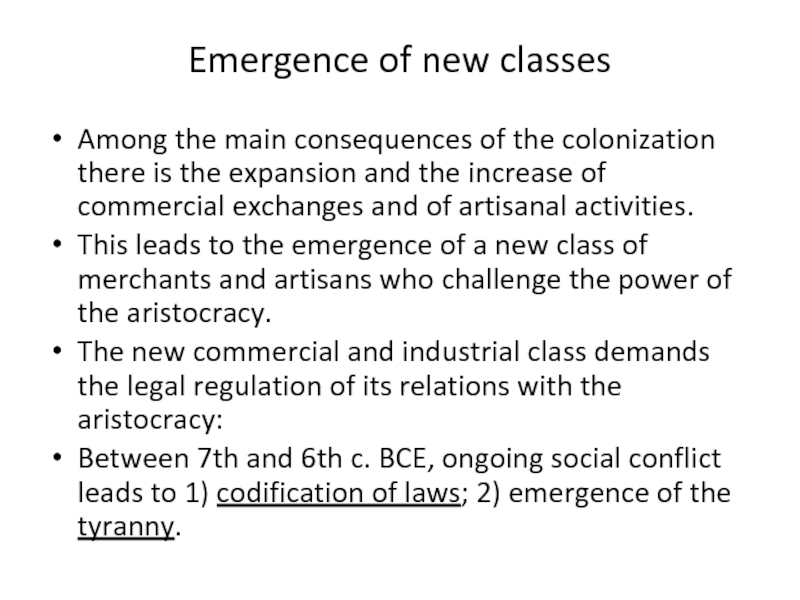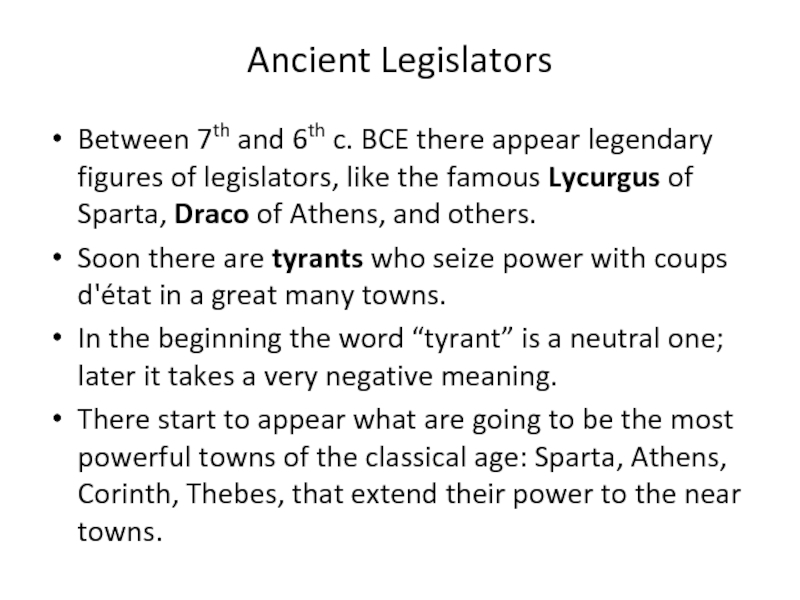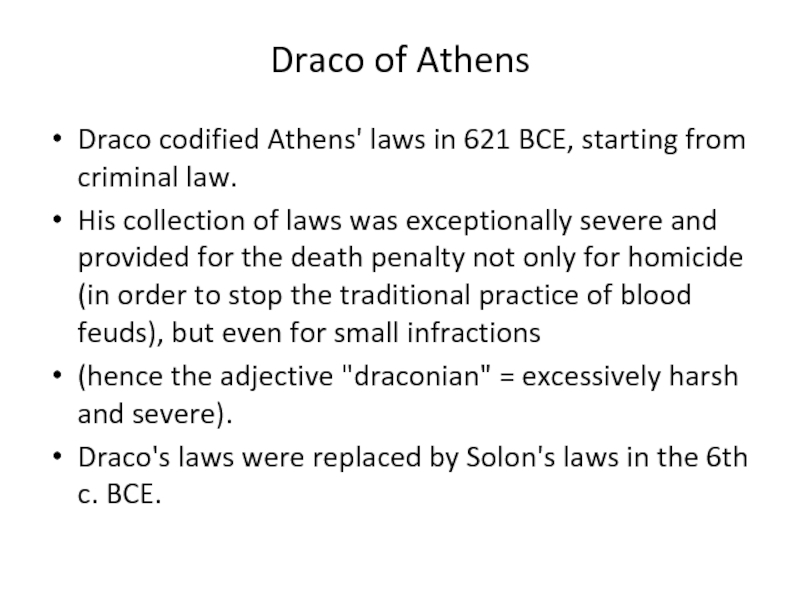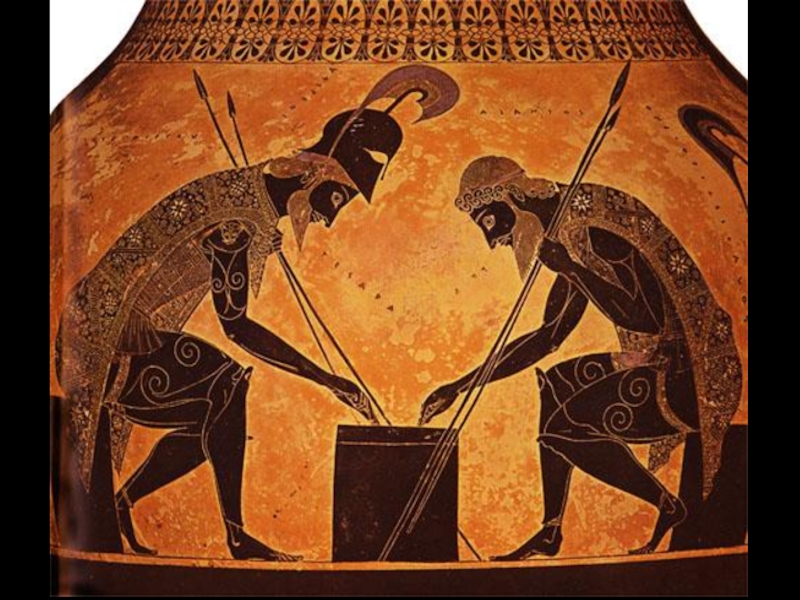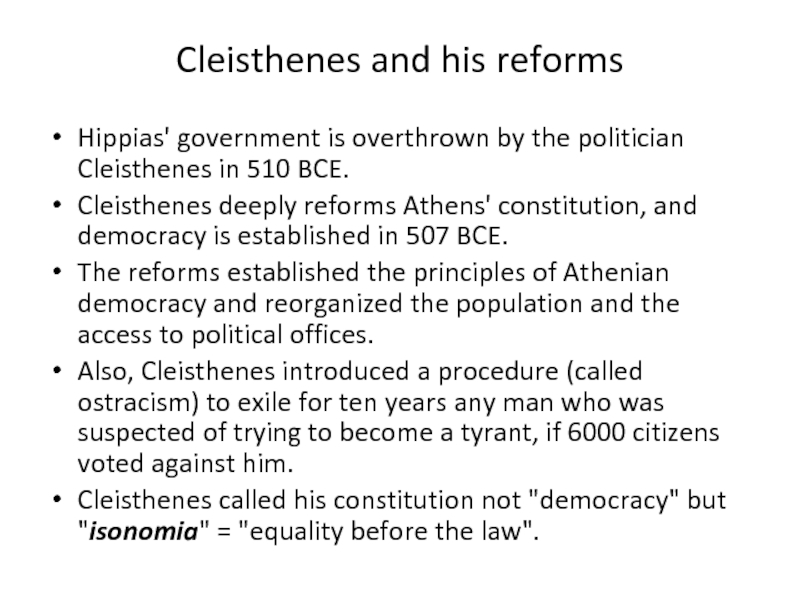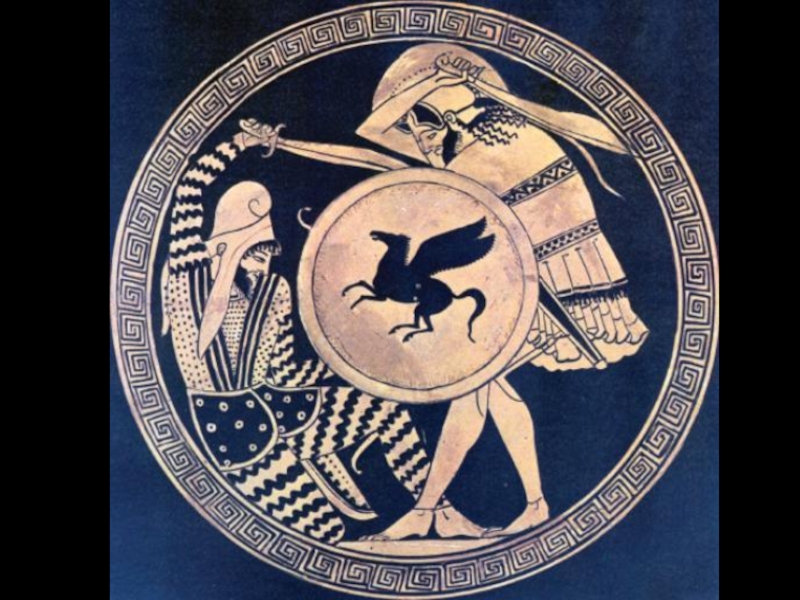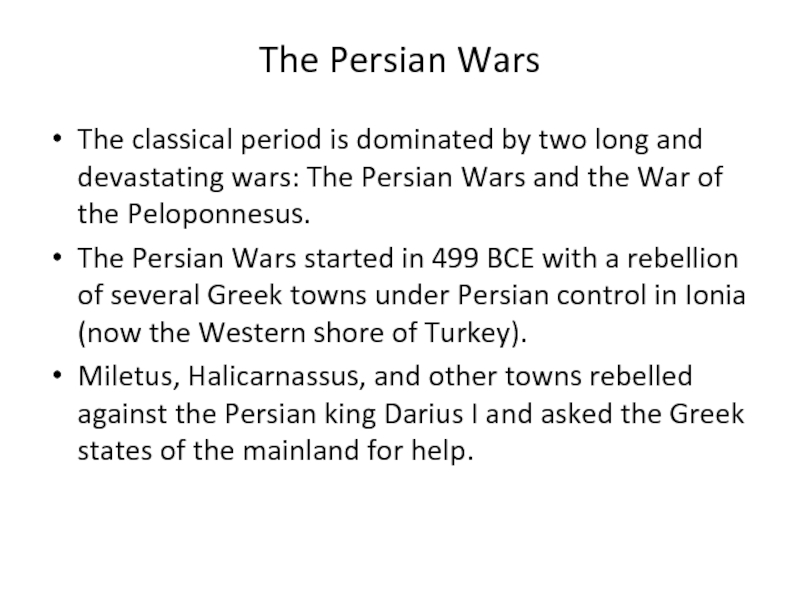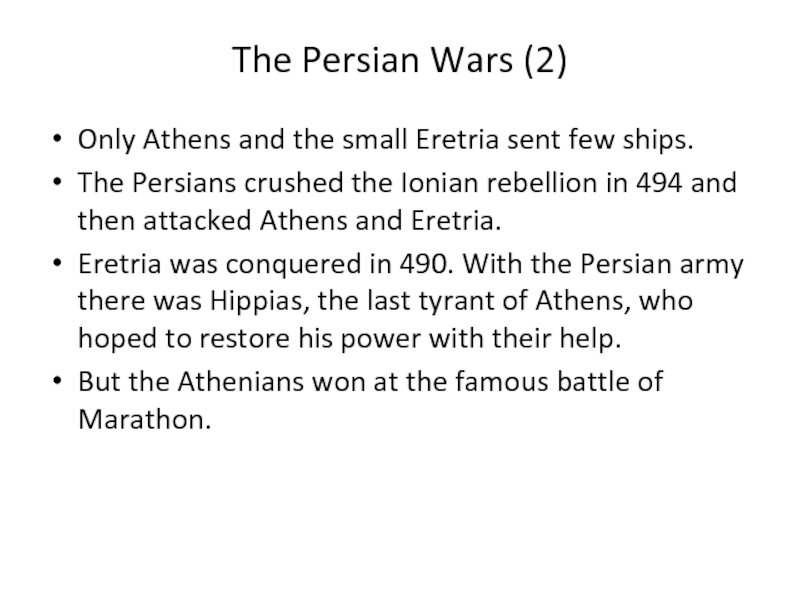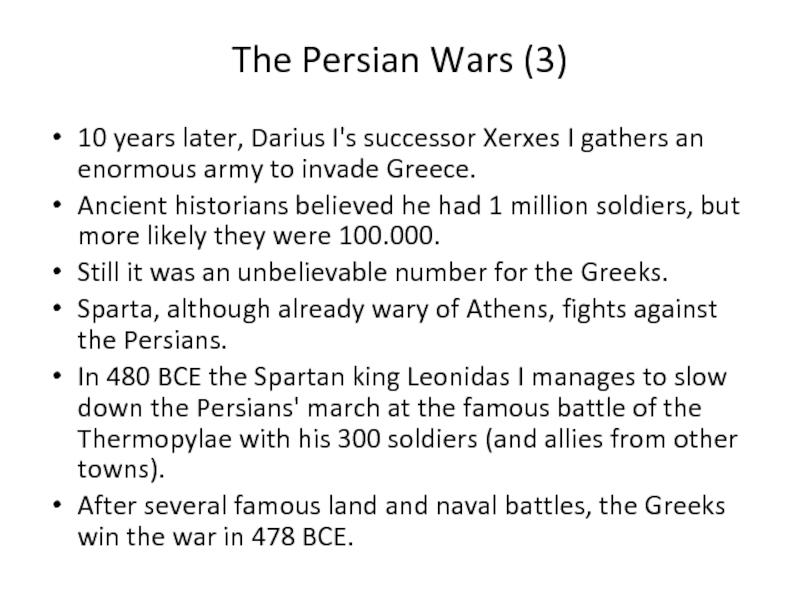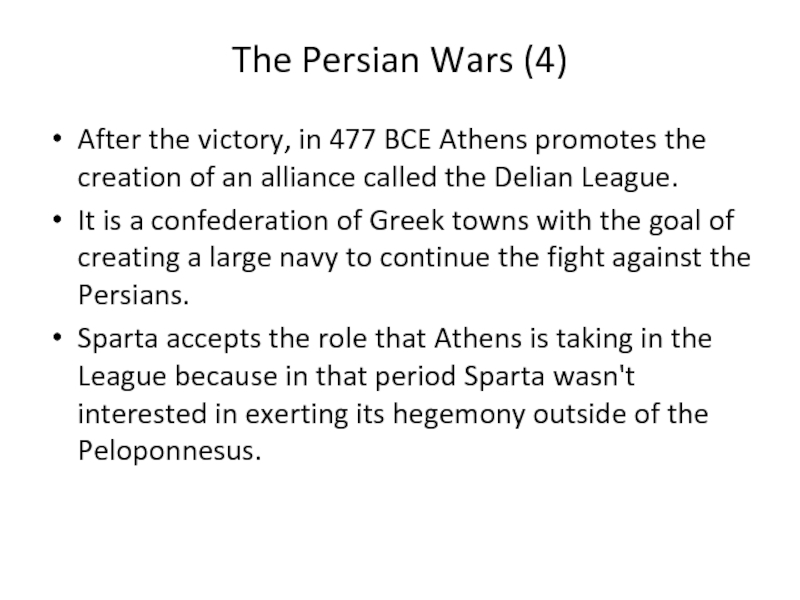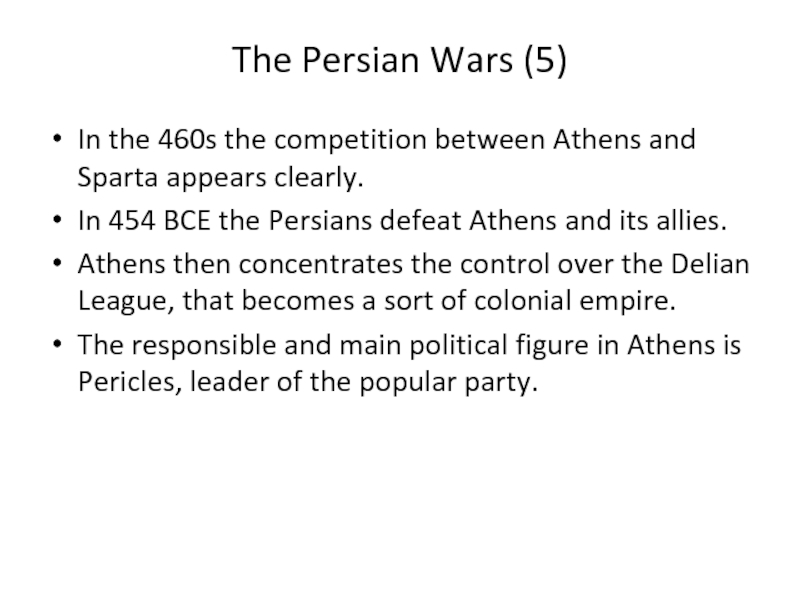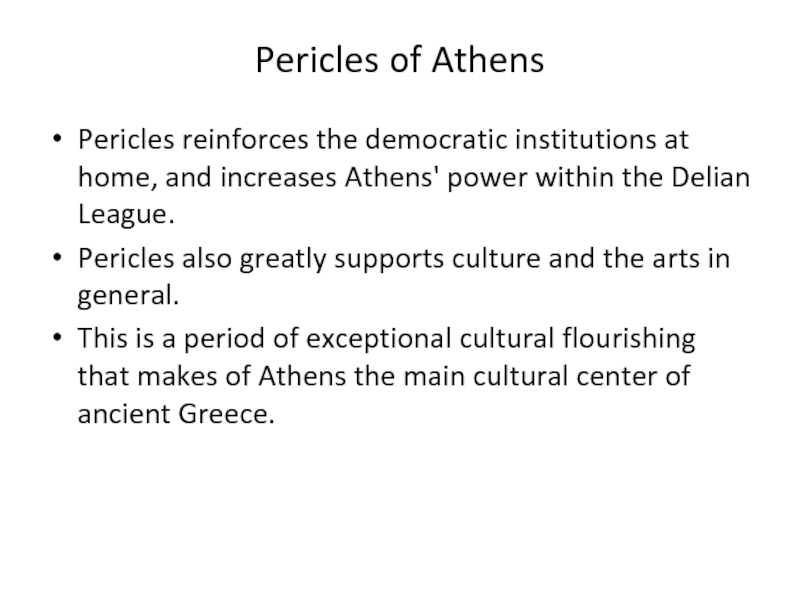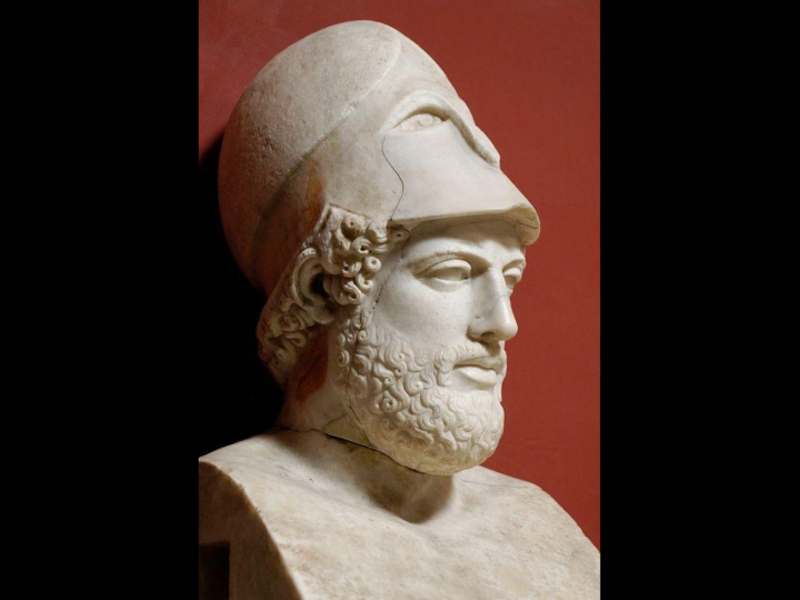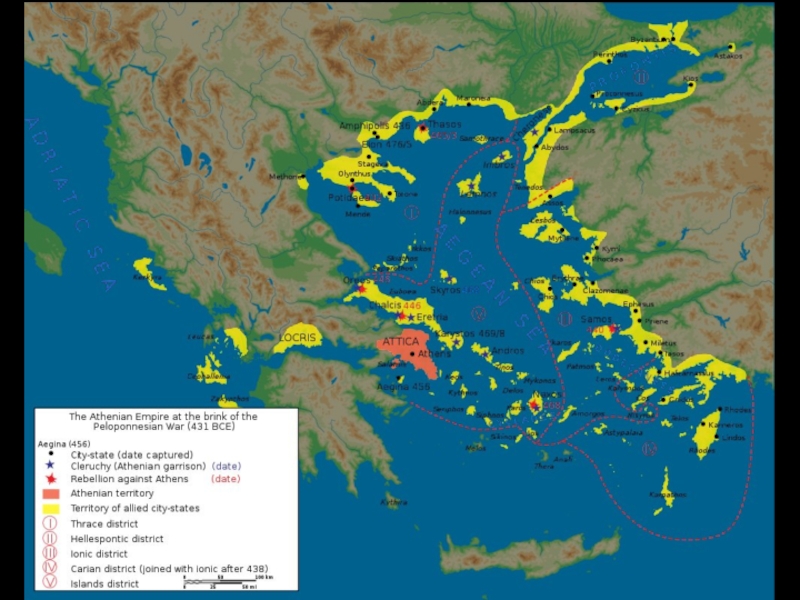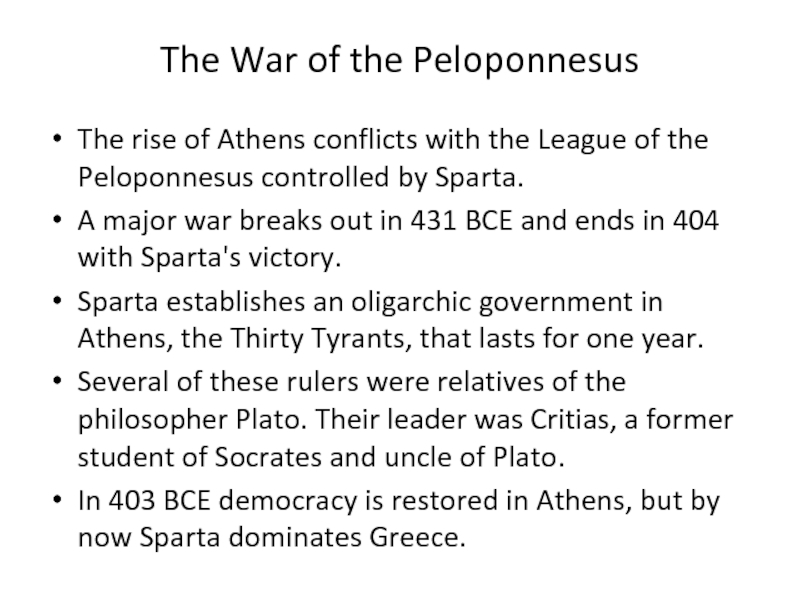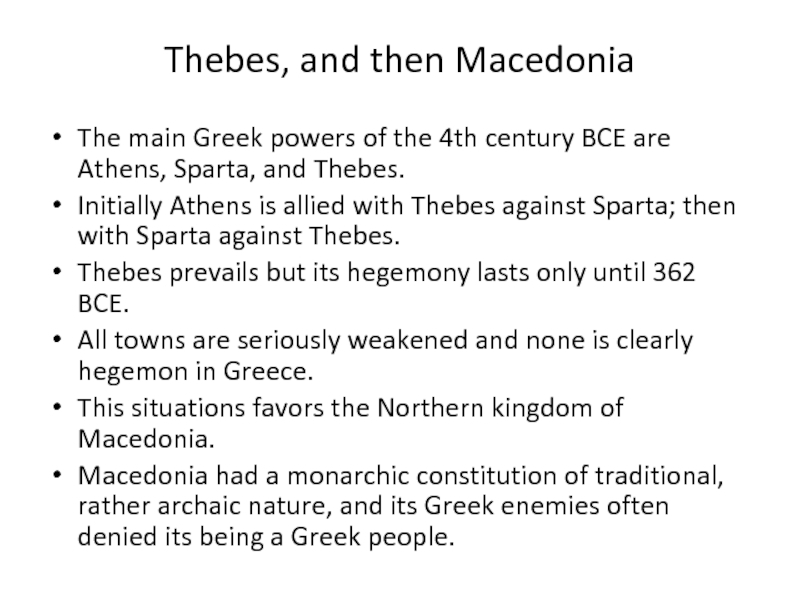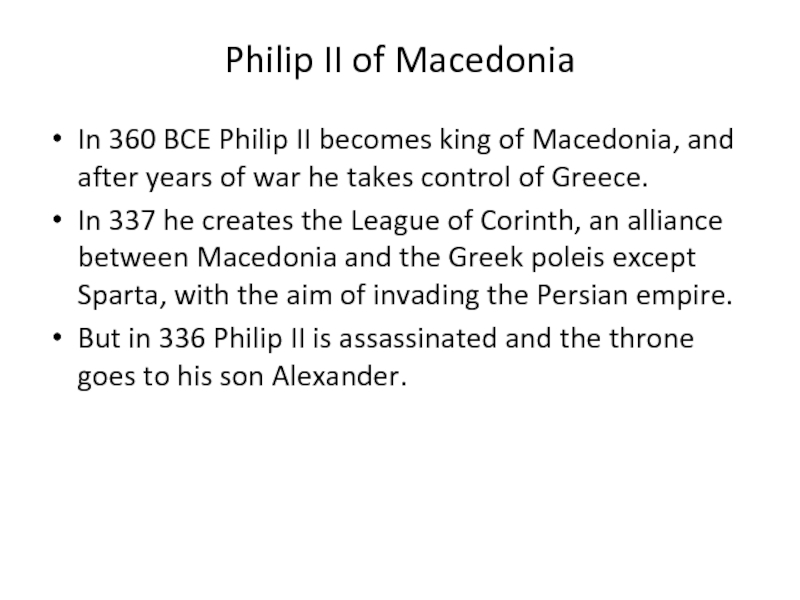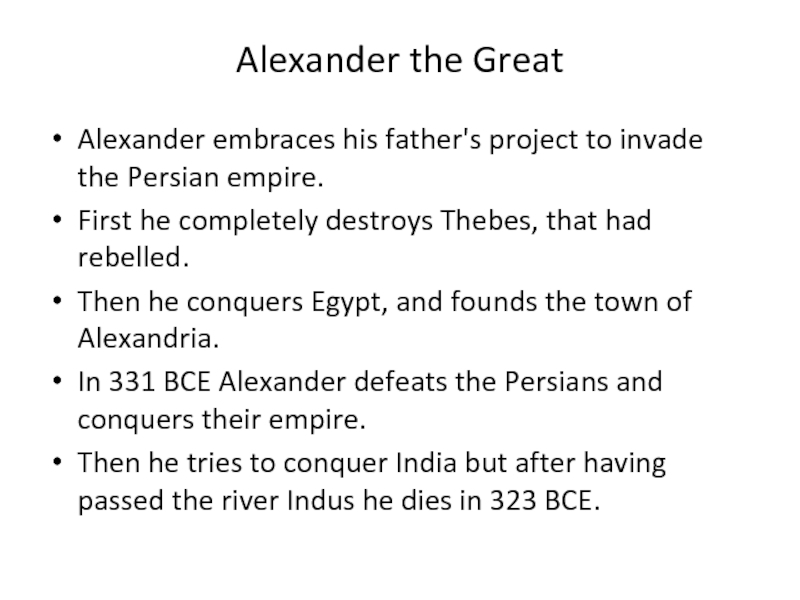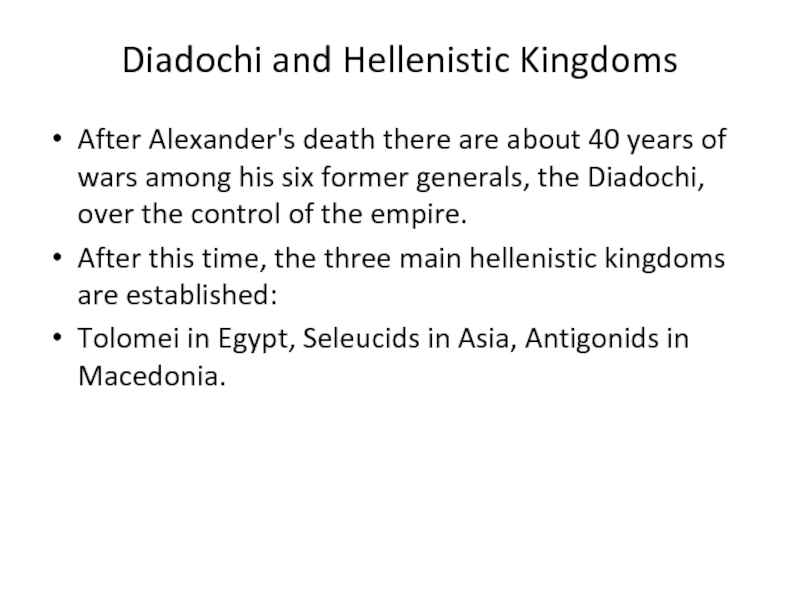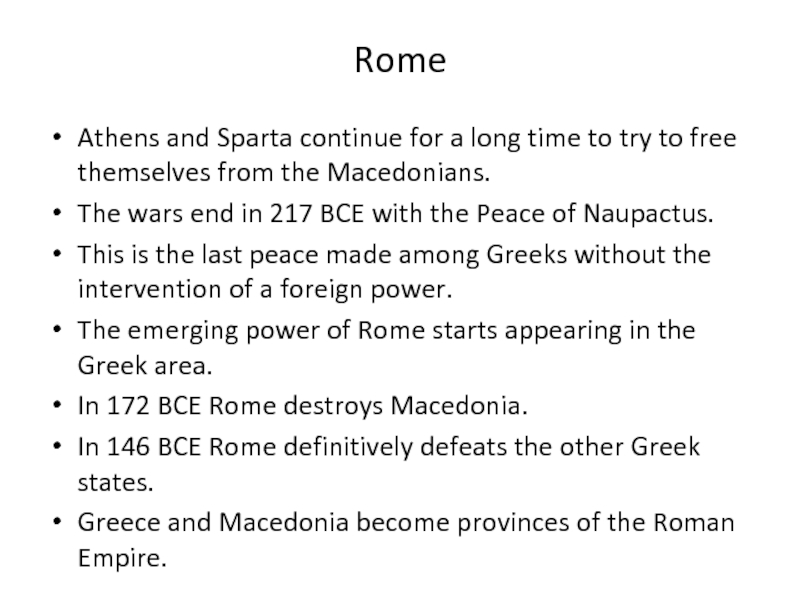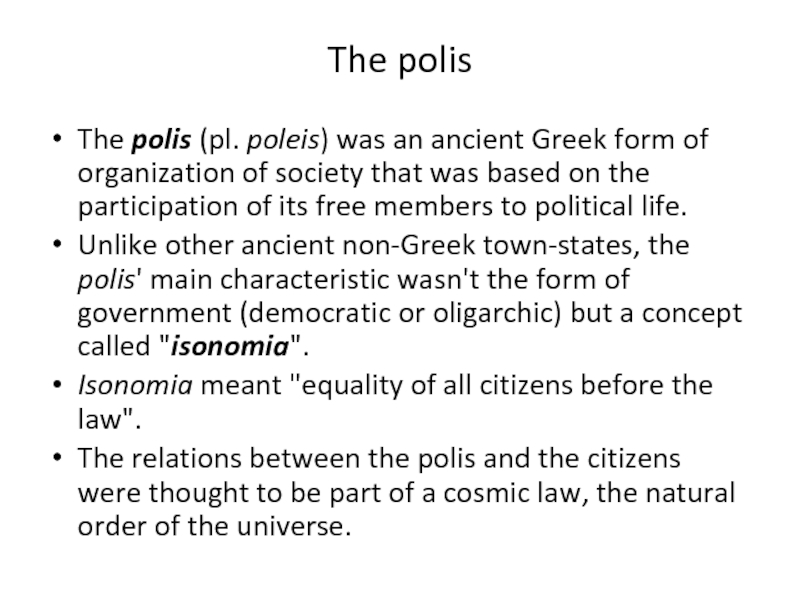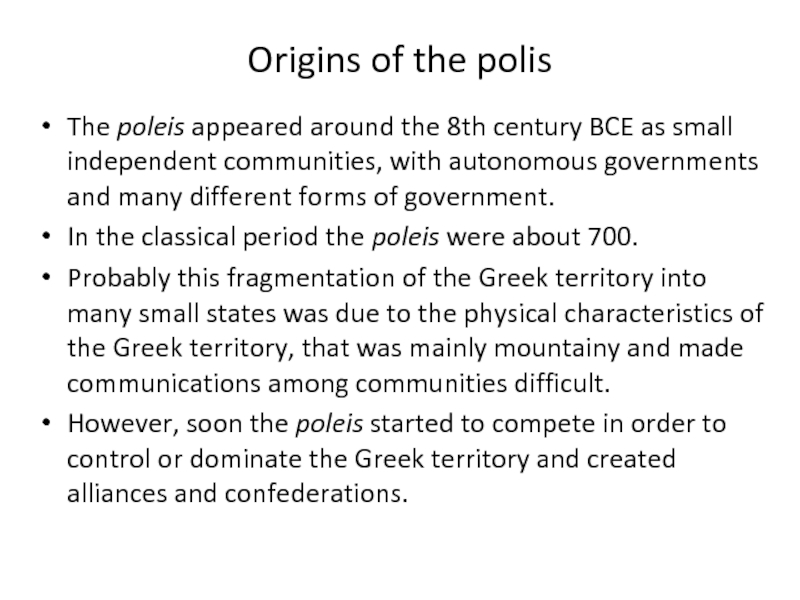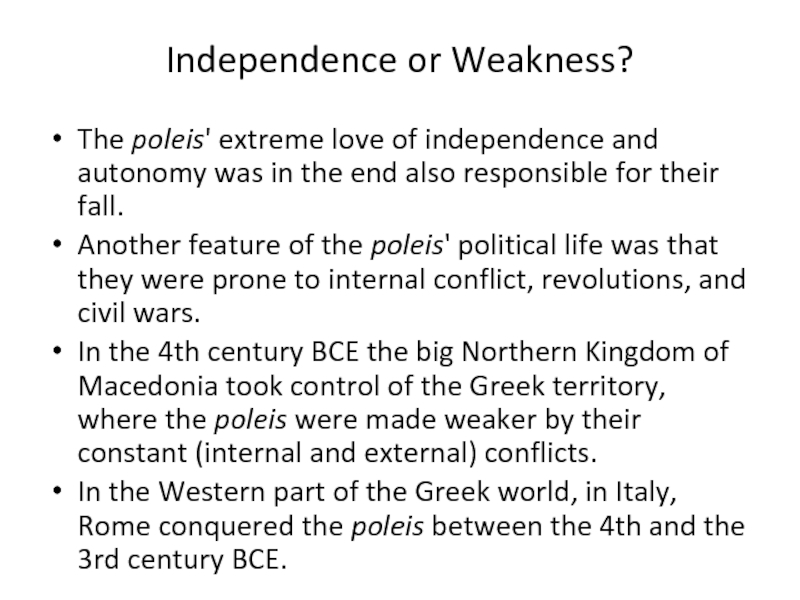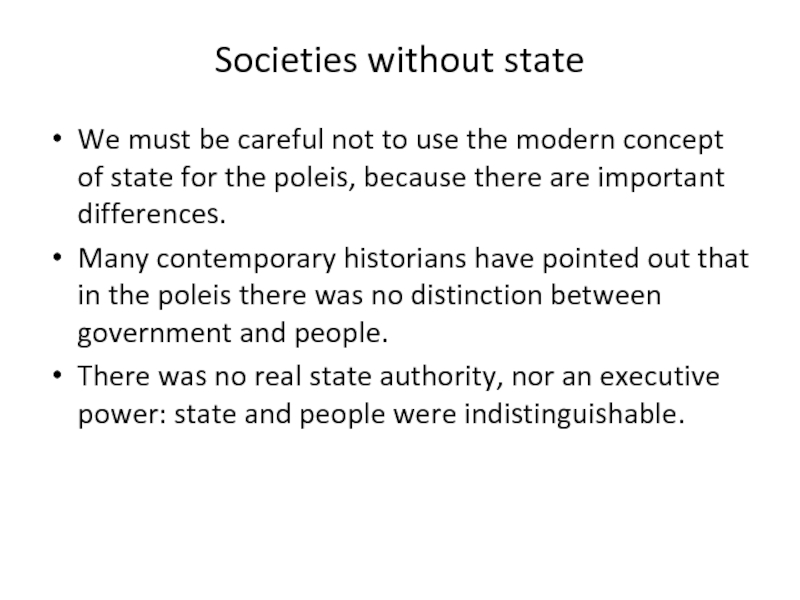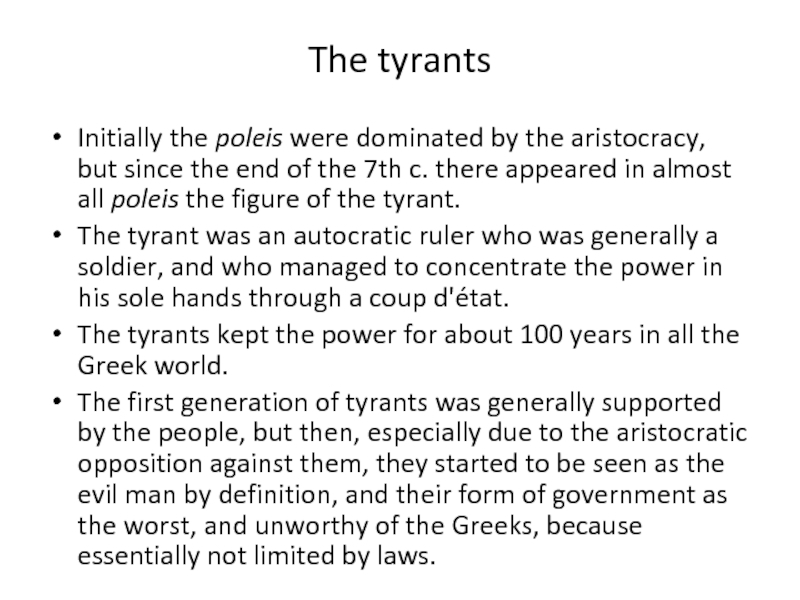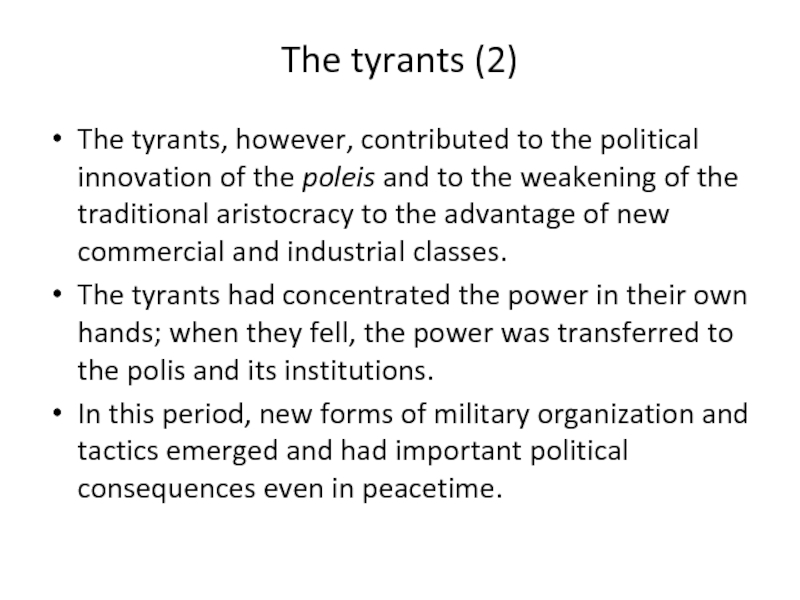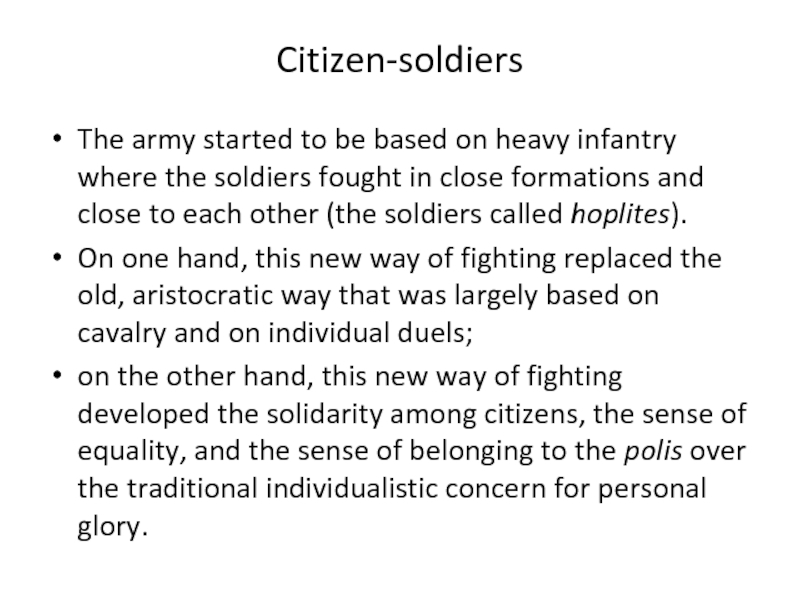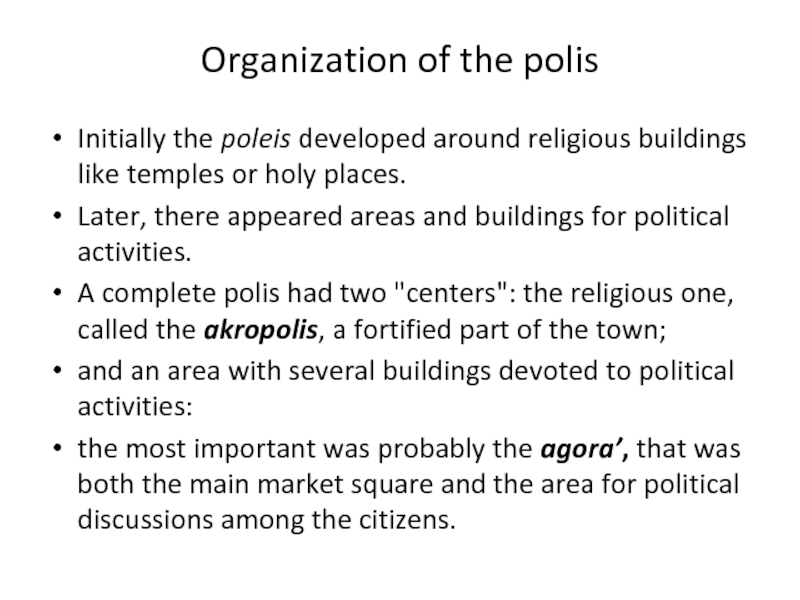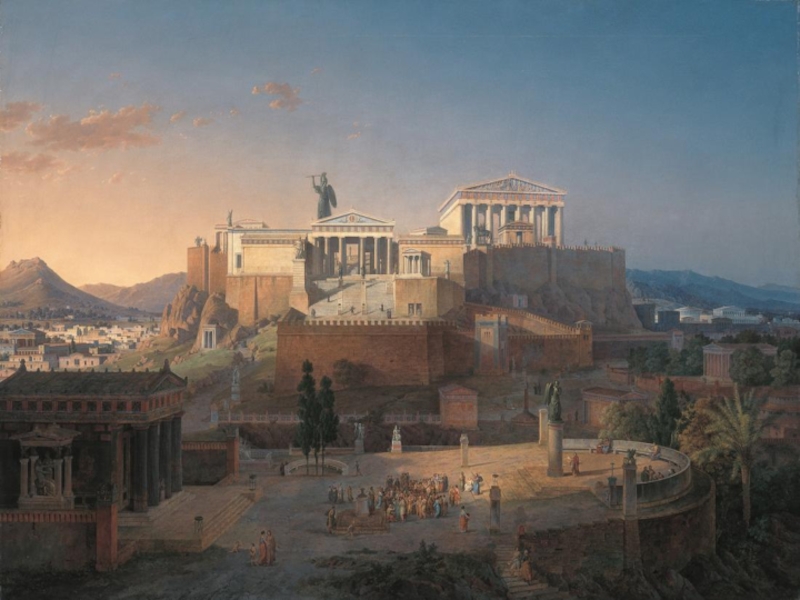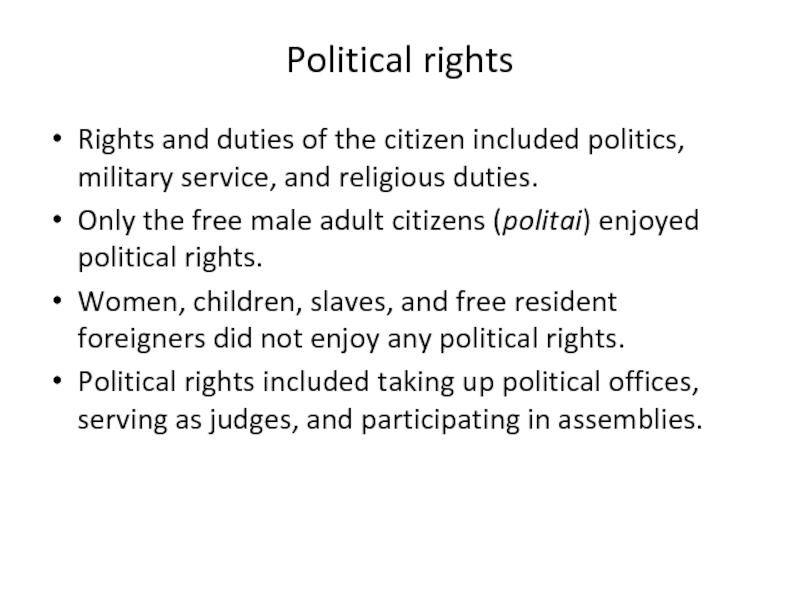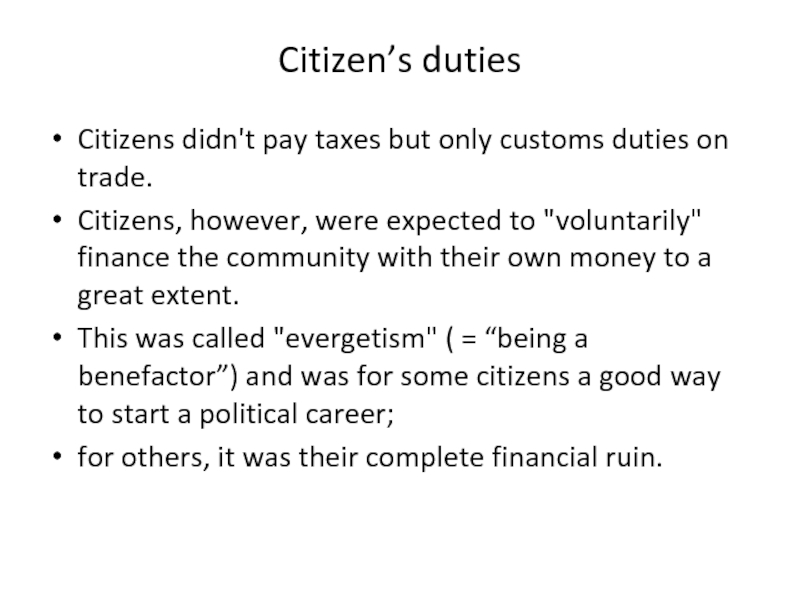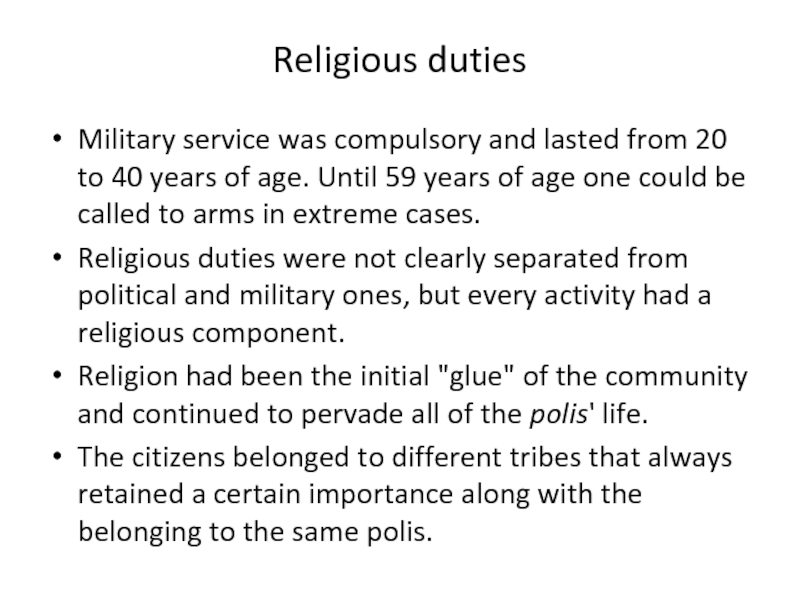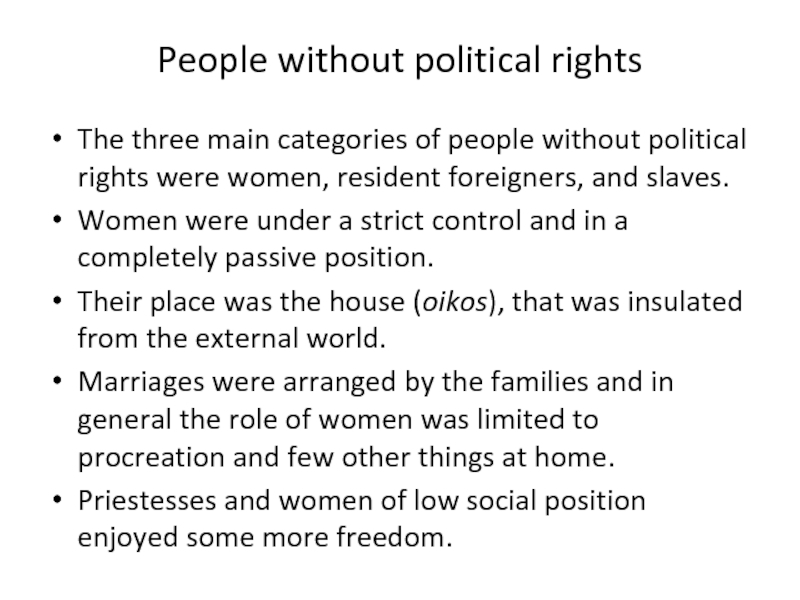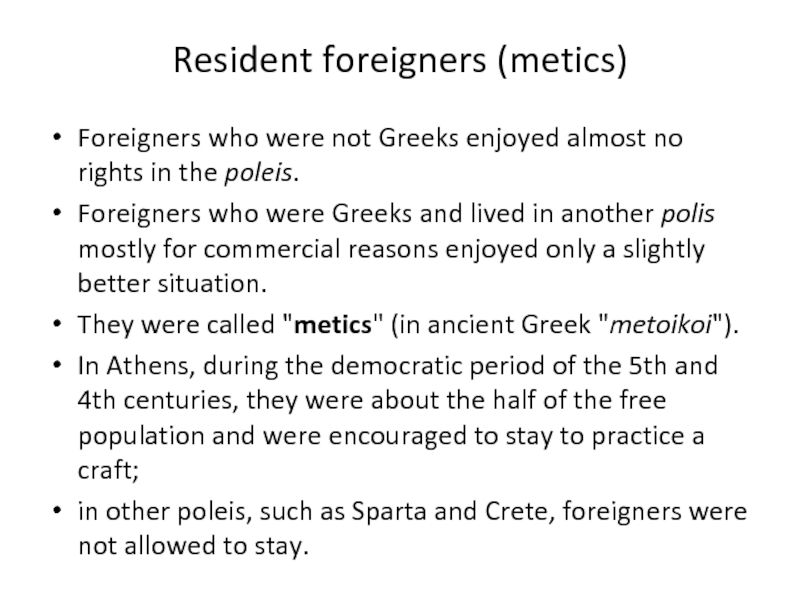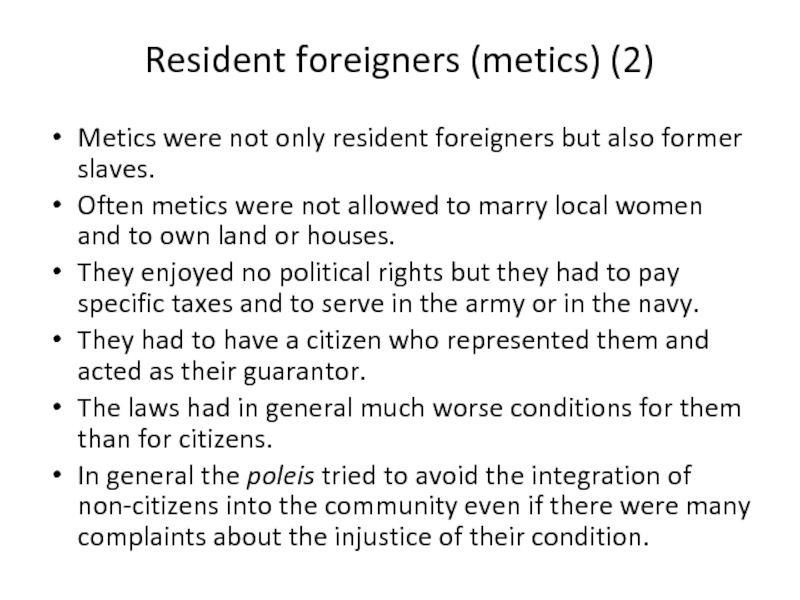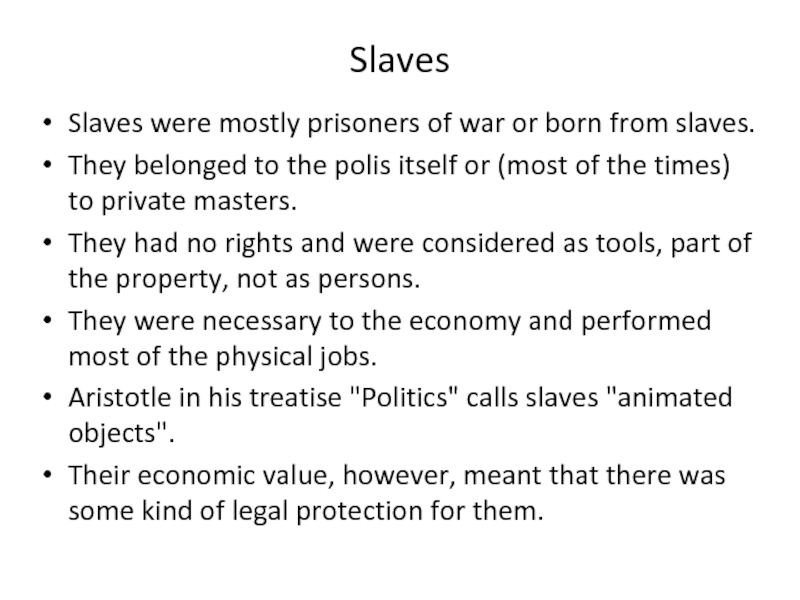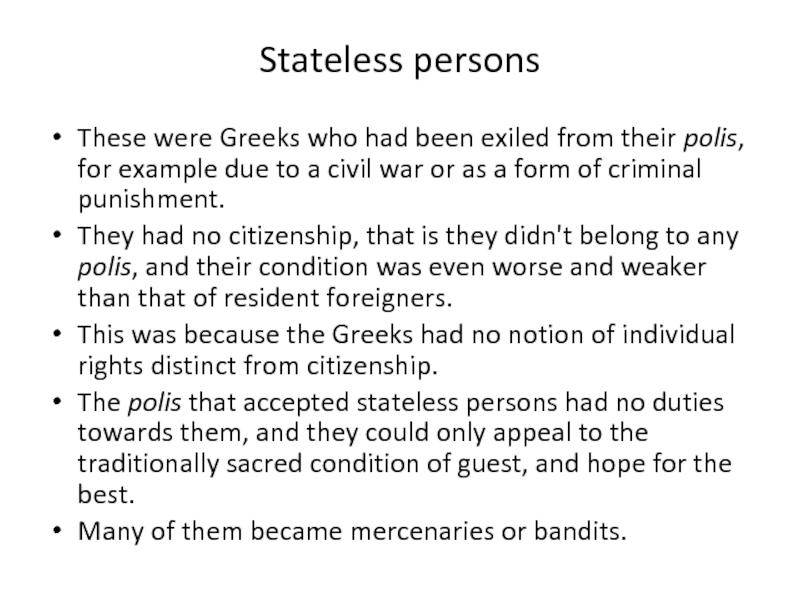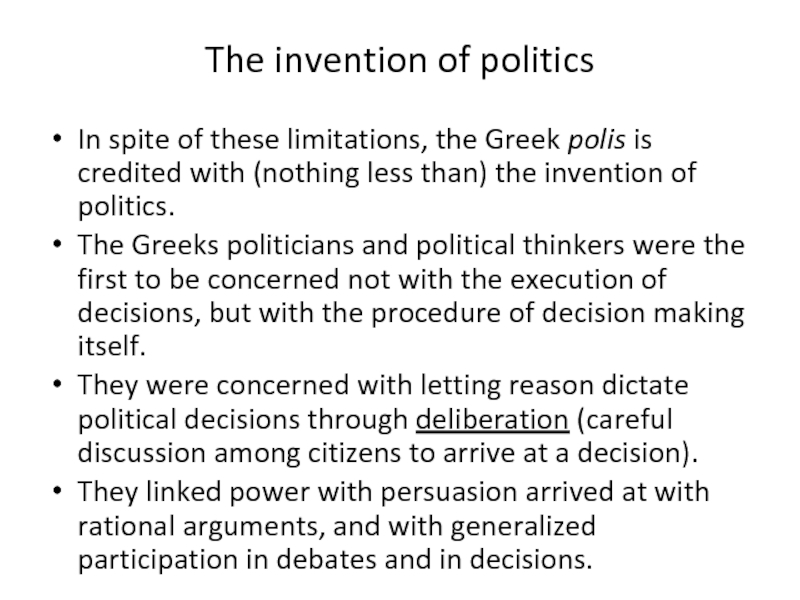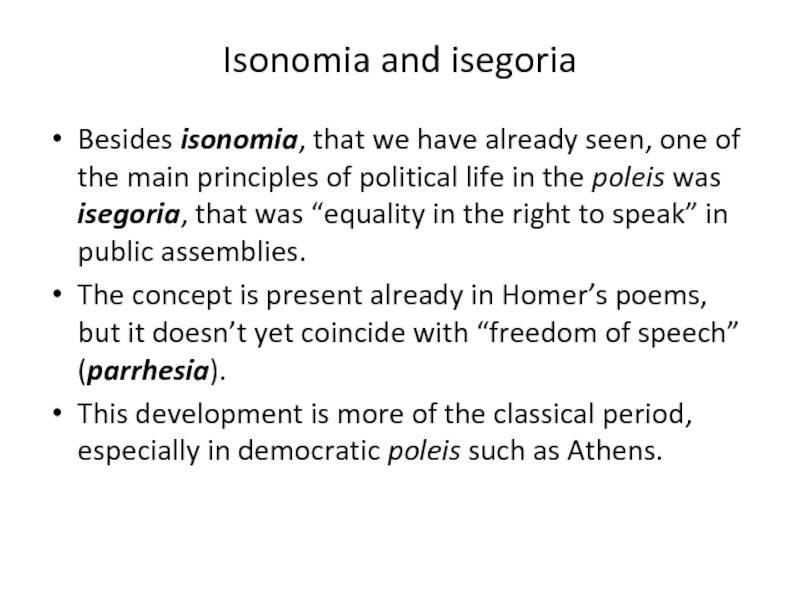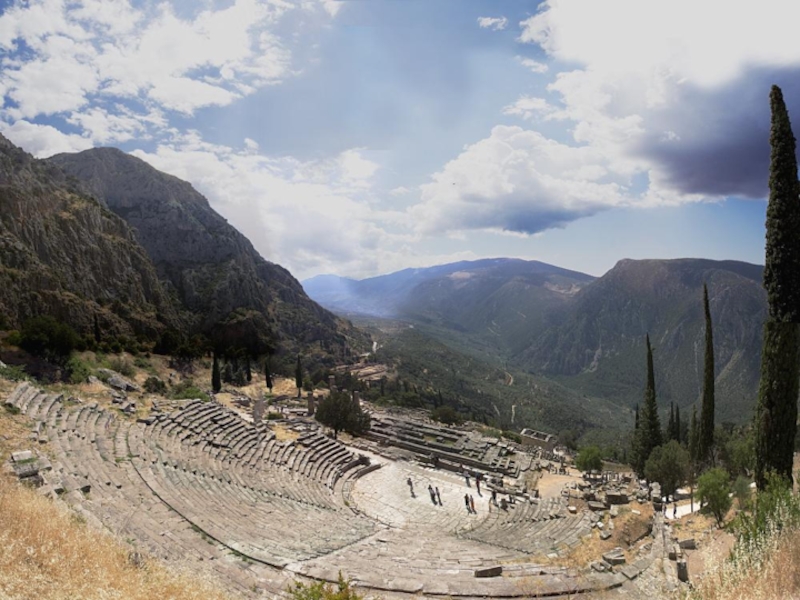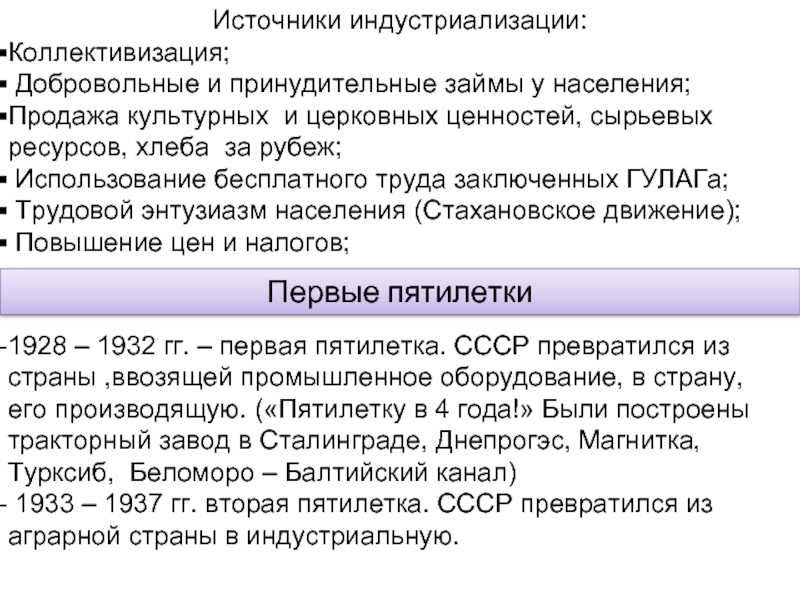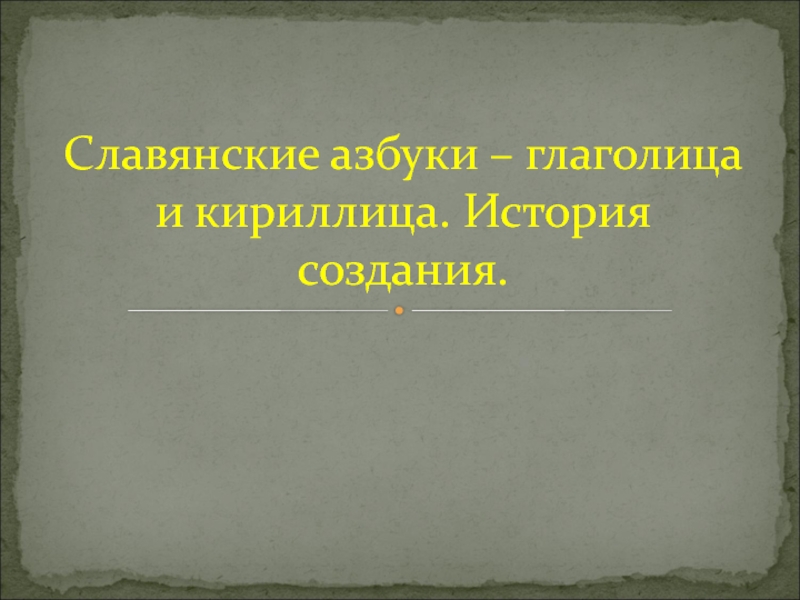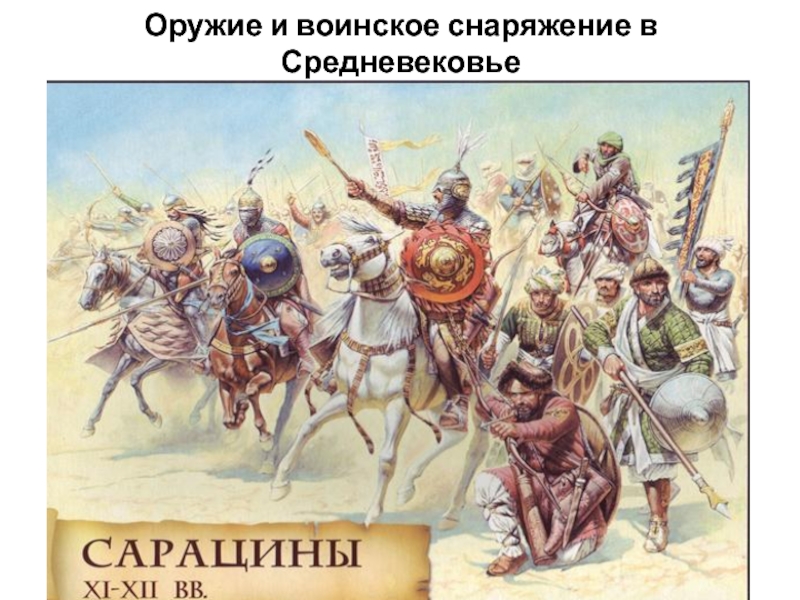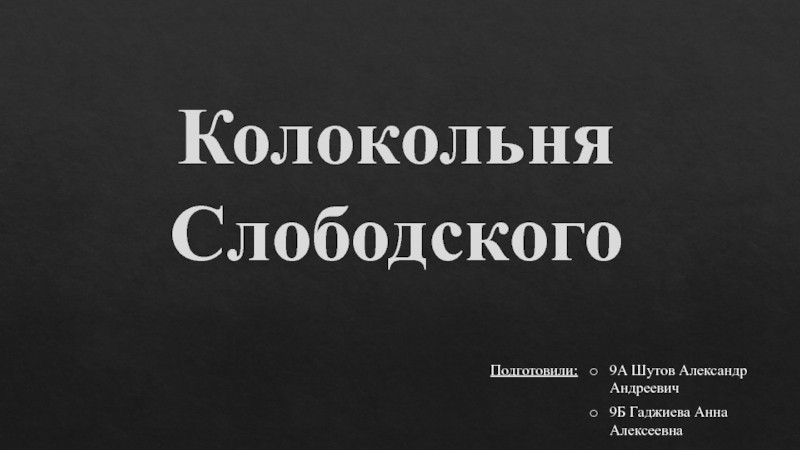- Главная
- Разное
- Дизайн
- Бизнес и предпринимательство
- Аналитика
- Образование
- Развлечения
- Красота и здоровье
- Финансы
- Государство
- Путешествия
- Спорт
- Недвижимость
- Армия
- Графика
- Культурология
- Еда и кулинария
- Лингвистика
- Английский язык
- Астрономия
- Алгебра
- Биология
- География
- Детские презентации
- Информатика
- История
- Литература
- Маркетинг
- Математика
- Медицина
- Менеджмент
- Музыка
- МХК
- Немецкий язык
- ОБЖ
- Обществознание
- Окружающий мир
- Педагогика
- Русский язык
- Технология
- Физика
- Философия
- Химия
- Шаблоны, картинки для презентаций
- Экология
- Экономика
- Юриспруденция
002 Greece and Greek Polis презентация
Содержание
- 1. 002 Greece and Greek Polis
- 2. The end of the archaic period In
- 3. Emergence of new classes Among the main
- 4. Ancient Legislators Between 7th and 6th c.
- 5. Lycurgus of Sparta Lycurgus of Sparta, mythical
- 6. Draco of Athens Draco codified Athens' laws
- 8. Tyrants Sparta's situation is a little exceptional.
- 9. Cleisthenes and his reforms Hippias' government is
- 10. THE CLASSICAL PERIOD
- 12. The Persian Wars The classical period is
- 13. The Persian Wars (2) Only Athens and
- 14. The Persian Wars (3) 10 years later,
- 15. The Persian Wars (4) After the victory,
- 16. The Persian Wars (5) In the 460s
- 17. Pericles of Athens Pericles reinforces the democratic
- 20. The War of the Peloponnesus The rise
- 21. Thebes, and then Macedonia The main Greek
- 22. Philip II of Macedonia In 360 BCE
- 23. Alexander the Great Alexander embraces his father's
- 24. THE HELLENISTIC PERIOD
- 25. Diadochi and Hellenistic Kingdoms After Alexander's death
- 26. Rome Athens and Sparta continue for a
- 27. THE POLIS
- 28. The polis The polis (pl. poleis) was
- 29. Origins of the polis The poleis appeared
- 30. Independence or Weakness? The poleis' extreme love
- 31. Societies without state We must be careful
- 32. The tyrants Initially the poleis were dominated
- 33. The tyrants (2) The tyrants, however, contributed
- 34. Citizen-soldiers The army started to be based
- 35. Organization of the polis Initially the poleis
- 37. Political rights Rights and duties of the
- 38. Citizen’s duties Citizens didn't pay taxes but
- 39. Religious duties Military service was compulsory and
- 40. People without political rights The three main
- 41. Resident foreigners (metics) Foreigners who were not
- 42. Resident foreigners (metics) (2) Metics were not
- 43. Slaves Slaves were mostly prisoners of war
- 44. Stateless persons These were Greeks who had
- 45. The invention of politics In spite of
- 46. “Man is a political animal” The Greeks,
- 47. Isonomia and isegoria Besides isonomia, that we
Слайд 2The end of the archaic period
In all the Greek world, between
the end of the 9th century and the 8th century BCE the aristocracy takes over the power of the traditional monarchy.
Between 8th and 7th century there are large migrations, with huge social, political, and economic consequences.
The main causes of these migrations are class conflicts, wars among the various towns, and a significant increase in population.
In the 8th c., from more archaic forms of society, there emerges a form of social and political organizations based on a town, the polis.
Between 8th and 7th century there are large migrations, with huge social, political, and economic consequences.
The main causes of these migrations are class conflicts, wars among the various towns, and a significant increase in population.
In the 8th c., from more archaic forms of society, there emerges a form of social and political organizations based on a town, the polis.
Слайд 3Emergence of new classes
Among the main consequences of the colonization there
is the expansion and the increase of commercial exchanges and of artisanal activities.
This leads to the emergence of a new class of merchants and artisans who challenge the power of the aristocracy.
The new commercial and industrial class demands the legal regulation of its relations with the aristocracy:
Between 7th and 6th c. BCE, ongoing social conflict leads to 1) codification of laws; 2) emergence of the tyranny.
This leads to the emergence of a new class of merchants and artisans who challenge the power of the aristocracy.
The new commercial and industrial class demands the legal regulation of its relations with the aristocracy:
Between 7th and 6th c. BCE, ongoing social conflict leads to 1) codification of laws; 2) emergence of the tyranny.
Слайд 4Ancient Legislators
Between 7th and 6th c. BCE there appear legendary figures
of legislators, like the famous Lycurgus of Sparta, Draco of Athens, and others.
Soon there are tyrants who seize power with coups d'état in a great many towns.
In the beginning the word “tyrant” is a neutral one; later it takes a very negative meaning.
There start to appear what are going to be the most powerful towns of the classical age: Sparta, Athens, Corinth, Thebes, that extend their power to the near towns.
Soon there are tyrants who seize power with coups d'état in a great many towns.
In the beginning the word “tyrant” is a neutral one; later it takes a very negative meaning.
There start to appear what are going to be the most powerful towns of the classical age: Sparta, Athens, Corinth, Thebes, that extend their power to the near towns.
Слайд 5Lycurgus of Sparta
Lycurgus of Sparta, mythical legislator, believed to have lived
between 8th and 7th c. BCE.
The tradition says that the oracle of Delphi suggested him a reform of Sparta's institutions.
He came up with a new constitution called "Great Rhetra" that was observed in Sparta for many centuries.
In the Great Rhetra there are established the main Spartan institutions, including:
the diarchy (the simultaneous presence of two kings); the council of the elders (gerusia); the people's assembly (apella); and Sparta's traditional, very strict educational system (called "agoge’").
The tradition says that the oracle of Delphi suggested him a reform of Sparta's institutions.
He came up with a new constitution called "Great Rhetra" that was observed in Sparta for many centuries.
In the Great Rhetra there are established the main Spartan institutions, including:
the diarchy (the simultaneous presence of two kings); the council of the elders (gerusia); the people's assembly (apella); and Sparta's traditional, very strict educational system (called "agoge’").
Слайд 6Draco of Athens
Draco codified Athens' laws in 621 BCE, starting from
criminal law.
His collection of laws was exceptionally severe and provided for the death penalty not only for homicide (in order to stop the traditional practice of blood feuds), but even for small infractions
(hence the adjective "draconian" = excessively harsh and severe).
Draco's laws were replaced by Solon's laws in the 6th c. BCE.
His collection of laws was exceptionally severe and provided for the death penalty not only for homicide (in order to stop the traditional practice of blood feuds), but even for small infractions
(hence the adjective "draconian" = excessively harsh and severe).
Draco's laws were replaced by Solon's laws in the 6th c. BCE.
Слайд 8Tyrants
Sparta's situation is a little exceptional. Very conservative, it keeps for
a long time Lycurgus' ancient constitution and doesn't have significant social conflicts, nor migrations.
In almost all other towns, instead, tyrants seize the power.
They are usually soldiers.
In Athens, Pisistratus rules for about 30 years (about 561-528 BCE) and transmits his power to his son Hippias.
In almost all other towns, instead, tyrants seize the power.
They are usually soldiers.
In Athens, Pisistratus rules for about 30 years (about 561-528 BCE) and transmits his power to his son Hippias.
Слайд 9Cleisthenes and his reforms
Hippias' government is overthrown by the politician Cleisthenes
in 510 BCE.
Cleisthenes deeply reforms Athens' constitution, and democracy is established in 507 BCE.
The reforms established the principles of Athenian democracy and reorganized the population and the access to political offices.
Also, Cleisthenes introduced a procedure (called ostracism) to exile for ten years any man who was suspected of trying to become a tyrant, if 6000 citizens voted against him.
Cleisthenes called his constitution not "democracy" but "isonomia" = "equality before the law".
Cleisthenes deeply reforms Athens' constitution, and democracy is established in 507 BCE.
The reforms established the principles of Athenian democracy and reorganized the population and the access to political offices.
Also, Cleisthenes introduced a procedure (called ostracism) to exile for ten years any man who was suspected of trying to become a tyrant, if 6000 citizens voted against him.
Cleisthenes called his constitution not "democracy" but "isonomia" = "equality before the law".
Слайд 12The Persian Wars
The classical period is dominated by two long and
devastating wars: The Persian Wars and the War of the Peloponnesus.
The Persian Wars started in 499 BCE with a rebellion of several Greek towns under Persian control in Ionia (now the Western shore of Turkey).
Miletus, Halicarnassus, and other towns rebelled against the Persian king Darius I and asked the Greek states of the mainland for help.
The Persian Wars started in 499 BCE with a rebellion of several Greek towns under Persian control in Ionia (now the Western shore of Turkey).
Miletus, Halicarnassus, and other towns rebelled against the Persian king Darius I and asked the Greek states of the mainland for help.
Слайд 13The Persian Wars (2)
Only Athens and the small Eretria sent few
ships.
The Persians crushed the Ionian rebellion in 494 and then attacked Athens and Eretria.
Eretria was conquered in 490. With the Persian army there was Hippias, the last tyrant of Athens, who hoped to restore his power with their help.
But the Athenians won at the famous battle of Marathon.
The Persians crushed the Ionian rebellion in 494 and then attacked Athens and Eretria.
Eretria was conquered in 490. With the Persian army there was Hippias, the last tyrant of Athens, who hoped to restore his power with their help.
But the Athenians won at the famous battle of Marathon.
Слайд 14The Persian Wars (3)
10 years later, Darius I's successor Xerxes I
gathers an enormous army to invade Greece.
Ancient historians believed he had 1 million soldiers, but more likely they were 100.000.
Still it was an unbelievable number for the Greeks.
Sparta, although already wary of Athens, fights against the Persians.
In 480 BCE the Spartan king Leonidas I manages to slow down the Persians' march at the famous battle of the Thermopylae with his 300 soldiers (and allies from other towns).
After several famous land and naval battles, the Greeks win the war in 478 BCE.
Ancient historians believed he had 1 million soldiers, but more likely they were 100.000.
Still it was an unbelievable number for the Greeks.
Sparta, although already wary of Athens, fights against the Persians.
In 480 BCE the Spartan king Leonidas I manages to slow down the Persians' march at the famous battle of the Thermopylae with his 300 soldiers (and allies from other towns).
After several famous land and naval battles, the Greeks win the war in 478 BCE.
Слайд 15The Persian Wars (4)
After the victory, in 477 BCE Athens promotes
the creation of an alliance called the Delian League.
It is a confederation of Greek towns with the goal of creating a large navy to continue the fight against the Persians.
Sparta accepts the role that Athens is taking in the League because in that period Sparta wasn't interested in exerting its hegemony outside of the Peloponnesus.
It is a confederation of Greek towns with the goal of creating a large navy to continue the fight against the Persians.
Sparta accepts the role that Athens is taking in the League because in that period Sparta wasn't interested in exerting its hegemony outside of the Peloponnesus.
Слайд 16The Persian Wars (5)
In the 460s the competition between Athens and
Sparta appears clearly.
In 454 BCE the Persians defeat Athens and its allies.
Athens then concentrates the control over the Delian League, that becomes a sort of colonial empire.
The responsible and main political figure in Athens is Pericles, leader of the popular party.
In 454 BCE the Persians defeat Athens and its allies.
Athens then concentrates the control over the Delian League, that becomes a sort of colonial empire.
The responsible and main political figure in Athens is Pericles, leader of the popular party.
Слайд 17Pericles of Athens
Pericles reinforces the democratic institutions at home, and increases
Athens' power within the Delian League.
Pericles also greatly supports culture and the arts in general.
This is a period of exceptional cultural flourishing that makes of Athens the main cultural center of ancient Greece.
Pericles also greatly supports culture and the arts in general.
This is a period of exceptional cultural flourishing that makes of Athens the main cultural center of ancient Greece.
Слайд 20The War of the Peloponnesus
The rise of Athens conflicts with the
League of the Peloponnesus controlled by Sparta.
A major war breaks out in 431 BCE and ends in 404 with Sparta's victory.
Sparta establishes an oligarchic government in Athens, the Thirty Tyrants, that lasts for one year.
Several of these rulers were relatives of the philosopher Plato. Their leader was Critias, a former student of Socrates and uncle of Plato.
In 403 BCE democracy is restored in Athens, but by now Sparta dominates Greece.
A major war breaks out in 431 BCE and ends in 404 with Sparta's victory.
Sparta establishes an oligarchic government in Athens, the Thirty Tyrants, that lasts for one year.
Several of these rulers were relatives of the philosopher Plato. Their leader was Critias, a former student of Socrates and uncle of Plato.
In 403 BCE democracy is restored in Athens, but by now Sparta dominates Greece.
Слайд 21Thebes, and then Macedonia
The main Greek powers of the 4th century
BCE are Athens, Sparta, and Thebes.
Initially Athens is allied with Thebes against Sparta; then with Sparta against Thebes.
Thebes prevails but its hegemony lasts only until 362 BCE.
All towns are seriously weakened and none is clearly hegemon in Greece.
This situations favors the Northern kingdom of Macedonia.
Macedonia had a monarchic constitution of traditional, rather archaic nature, and its Greek enemies often denied its being a Greek people.
Initially Athens is allied with Thebes against Sparta; then with Sparta against Thebes.
Thebes prevails but its hegemony lasts only until 362 BCE.
All towns are seriously weakened and none is clearly hegemon in Greece.
This situations favors the Northern kingdom of Macedonia.
Macedonia had a monarchic constitution of traditional, rather archaic nature, and its Greek enemies often denied its being a Greek people.
Слайд 22Philip II of Macedonia
In 360 BCE Philip II becomes king of
Macedonia, and after years of war he takes control of Greece.
In 337 he creates the League of Corinth, an alliance between Macedonia and the Greek poleis except Sparta, with the aim of invading the Persian empire.
But in 336 Philip II is assassinated and the throne goes to his son Alexander.
In 337 he creates the League of Corinth, an alliance between Macedonia and the Greek poleis except Sparta, with the aim of invading the Persian empire.
But in 336 Philip II is assassinated and the throne goes to his son Alexander.
Слайд 23Alexander the Great
Alexander embraces his father's project to invade the Persian
empire.
First he completely destroys Thebes, that had rebelled.
Then he conquers Egypt, and founds the town of Alexandria.
In 331 BCE Alexander defeats the Persians and conquers their empire.
Then he tries to conquer India but after having passed the river Indus he dies in 323 BCE.
First he completely destroys Thebes, that had rebelled.
Then he conquers Egypt, and founds the town of Alexandria.
In 331 BCE Alexander defeats the Persians and conquers their empire.
Then he tries to conquer India but after having passed the river Indus he dies in 323 BCE.
Слайд 25Diadochi and Hellenistic Kingdoms
After Alexander's death there are about 40 years
of wars among his six former generals, the Diadochi, over the control of the empire.
After this time, the three main hellenistic kingdoms are established:
Tolomei in Egypt, Seleucids in Asia, Antigonids in Macedonia.
After this time, the three main hellenistic kingdoms are established:
Tolomei in Egypt, Seleucids in Asia, Antigonids in Macedonia.
Слайд 26Rome
Athens and Sparta continue for a long time to try to
free themselves from the Macedonians.
The wars end in 217 BCE with the Peace of Naupactus.
This is the last peace made among Greeks without the intervention of a foreign power.
The emerging power of Rome starts appearing in the Greek area.
In 172 BCE Rome destroys Macedonia.
In 146 BCE Rome definitively defeats the other Greek states.
Greece and Macedonia become provinces of the Roman Empire.
The wars end in 217 BCE with the Peace of Naupactus.
This is the last peace made among Greeks without the intervention of a foreign power.
The emerging power of Rome starts appearing in the Greek area.
In 172 BCE Rome destroys Macedonia.
In 146 BCE Rome definitively defeats the other Greek states.
Greece and Macedonia become provinces of the Roman Empire.
Слайд 28The polis
The polis (pl. poleis) was an ancient Greek form of
organization of society that was based on the participation of its free members to political life.
Unlike other ancient non-Greek town-states, the polis' main characteristic wasn't the form of government (democratic or oligarchic) but a concept called "isonomia".
Isonomia meant "equality of all citizens before the law".
The relations between the polis and the citizens were thought to be part of a cosmic law, the natural order of the universe.
Unlike other ancient non-Greek town-states, the polis' main characteristic wasn't the form of government (democratic or oligarchic) but a concept called "isonomia".
Isonomia meant "equality of all citizens before the law".
The relations between the polis and the citizens were thought to be part of a cosmic law, the natural order of the universe.
Слайд 29Origins of the polis
The poleis appeared around the 8th century BCE
as small independent communities, with autonomous governments and many different forms of government.
In the classical period the poleis were about 700.
Probably this fragmentation of the Greek territory into many small states was due to the physical characteristics of the Greek territory, that was mainly mountainy and made communications among communities difficult.
However, soon the poleis started to compete in order to control or dominate the Greek territory and created alliances and confederations.
In the classical period the poleis were about 700.
Probably this fragmentation of the Greek territory into many small states was due to the physical characteristics of the Greek territory, that was mainly mountainy and made communications among communities difficult.
However, soon the poleis started to compete in order to control or dominate the Greek territory and created alliances and confederations.
Слайд 30Independence or Weakness?
The poleis' extreme love of independence and autonomy was
in the end also responsible for their fall.
Another feature of the poleis' political life was that they were prone to internal conflict, revolutions, and civil wars.
In the 4th century BCE the big Northern Kingdom of Macedonia took control of the Greek territory, where the poleis were made weaker by their constant (internal and external) conflicts.
In the Western part of the Greek world, in Italy, Rome conquered the poleis between the 4th and the 3rd century BCE.
Another feature of the poleis' political life was that they were prone to internal conflict, revolutions, and civil wars.
In the 4th century BCE the big Northern Kingdom of Macedonia took control of the Greek territory, where the poleis were made weaker by their constant (internal and external) conflicts.
In the Western part of the Greek world, in Italy, Rome conquered the poleis between the 4th and the 3rd century BCE.
Слайд 31Societies without state
We must be careful not to use the modern
concept of state for the poleis, because there are important differences.
Many contemporary historians have pointed out that in the poleis there was no distinction between government and people.
There was no real state authority, nor an executive power: state and people were indistinguishable.
Many contemporary historians have pointed out that in the poleis there was no distinction between government and people.
There was no real state authority, nor an executive power: state and people were indistinguishable.
Слайд 32The tyrants
Initially the poleis were dominated by the aristocracy, but since
the end of the 7th c. there appeared in almost all poleis the figure of the tyrant.
The tyrant was an autocratic ruler who was generally a soldier, and who managed to concentrate the power in his sole hands through a coup d'état.
The tyrants kept the power for about 100 years in all the Greek world.
The first generation of tyrants was generally supported by the people, but then, especially due to the aristocratic opposition against them, they started to be seen as the evil man by definition, and their form of government as the worst, and unworthy of the Greeks, because essentially not limited by laws.
The tyrant was an autocratic ruler who was generally a soldier, and who managed to concentrate the power in his sole hands through a coup d'état.
The tyrants kept the power for about 100 years in all the Greek world.
The first generation of tyrants was generally supported by the people, but then, especially due to the aristocratic opposition against them, they started to be seen as the evil man by definition, and their form of government as the worst, and unworthy of the Greeks, because essentially not limited by laws.
Слайд 33The tyrants (2)
The tyrants, however, contributed to the political innovation of
the poleis and to the weakening of the traditional aristocracy to the advantage of new commercial and industrial classes.
The tyrants had concentrated the power in their own hands; when they fell, the power was transferred to the polis and its institutions.
In this period, new forms of military organization and tactics emerged and had important political consequences even in peacetime.
The tyrants had concentrated the power in their own hands; when they fell, the power was transferred to the polis and its institutions.
In this period, new forms of military organization and tactics emerged and had important political consequences even in peacetime.
Слайд 34Citizen-soldiers
The army started to be based on heavy infantry where the
soldiers fought in close formations and close to each other (the soldiers called hoplites).
On one hand, this new way of fighting replaced the old, aristocratic way that was largely based on cavalry and on individual duels;
on the other hand, this new way of fighting developed the solidarity among citizens, the sense of equality, and the sense of belonging to the polis over the traditional individualistic concern for personal glory.
On one hand, this new way of fighting replaced the old, aristocratic way that was largely based on cavalry and on individual duels;
on the other hand, this new way of fighting developed the solidarity among citizens, the sense of equality, and the sense of belonging to the polis over the traditional individualistic concern for personal glory.
Слайд 35Organization of the polis
Initially the poleis developed around religious buildings like
temples or holy places.
Later, there appeared areas and buildings for political activities.
A complete polis had two "centers": the religious one, called the akropolis, a fortified part of the town;
and an area with several buildings devoted to political activities:
the most important was probably the agora’, that was both the main market square and the area for political discussions among the citizens.
Later, there appeared areas and buildings for political activities.
A complete polis had two "centers": the religious one, called the akropolis, a fortified part of the town;
and an area with several buildings devoted to political activities:
the most important was probably the agora’, that was both the main market square and the area for political discussions among the citizens.
Слайд 37Political rights
Rights and duties of the citizen included politics, military service,
and religious duties.
Only the free male adult citizens (politai) enjoyed political rights.
Women, children, slaves, and free resident foreigners did not enjoy any political rights.
Political rights included taking up political offices, serving as judges, and participating in assemblies.
Only the free male adult citizens (politai) enjoyed political rights.
Women, children, slaves, and free resident foreigners did not enjoy any political rights.
Political rights included taking up political offices, serving as judges, and participating in assemblies.
Слайд 38Citizen’s duties
Citizens didn't pay taxes but only customs duties on trade.
Citizens,
however, were expected to "voluntarily" finance the community with their own money to a great extent.
This was called "evergetism" ( = “being a benefactor”) and was for some citizens a good way to start a political career;
for others, it was their complete financial ruin.
This was called "evergetism" ( = “being a benefactor”) and was for some citizens a good way to start a political career;
for others, it was their complete financial ruin.
Слайд 39Religious duties
Military service was compulsory and lasted from 20 to 40
years of age. Until 59 years of age one could be called to arms in extreme cases.
Religious duties were not clearly separated from political and military ones, but every activity had a religious component.
Religion had been the initial "glue" of the community and continued to pervade all of the polis' life.
The citizens belonged to different tribes that always retained a certain importance along with the belonging to the same polis.
Religious duties were not clearly separated from political and military ones, but every activity had a religious component.
Religion had been the initial "glue" of the community and continued to pervade all of the polis' life.
The citizens belonged to different tribes that always retained a certain importance along with the belonging to the same polis.
Слайд 40People without political rights
The three main categories of people without political
rights were women, resident foreigners, and slaves.
Women were under a strict control and in a completely passive position.
Their place was the house (oikos), that was insulated from the external world.
Marriages were arranged by the families and in general the role of women was limited to procreation and few other things at home.
Priestesses and women of low social position enjoyed some more freedom.
Women were under a strict control and in a completely passive position.
Their place was the house (oikos), that was insulated from the external world.
Marriages were arranged by the families and in general the role of women was limited to procreation and few other things at home.
Priestesses and women of low social position enjoyed some more freedom.
Слайд 41Resident foreigners (metics)
Foreigners who were not Greeks enjoyed almost no rights
in the poleis.
Foreigners who were Greeks and lived in another polis mostly for commercial reasons enjoyed only a slightly better situation.
They were called "metics" (in ancient Greek "metoikoi").
In Athens, during the democratic period of the 5th and 4th centuries, they were about the half of the free population and were encouraged to stay to practice a craft;
in other poleis, such as Sparta and Crete, foreigners were not allowed to stay.
Foreigners who were Greeks and lived in another polis mostly for commercial reasons enjoyed only a slightly better situation.
They were called "metics" (in ancient Greek "metoikoi").
In Athens, during the democratic period of the 5th and 4th centuries, they were about the half of the free population and were encouraged to stay to practice a craft;
in other poleis, such as Sparta and Crete, foreigners were not allowed to stay.
Слайд 42Resident foreigners (metics) (2)
Metics were not only resident foreigners but also
former slaves.
Often metics were not allowed to marry local women and to own land or houses.
They enjoyed no political rights but they had to pay specific taxes and to serve in the army or in the navy.
They had to have a citizen who represented them and acted as their guarantor.
The laws had in general much worse conditions for them than for citizens.
In general the poleis tried to avoid the integration of non-citizens into the community even if there were many complaints about the injustice of their condition.
Often metics were not allowed to marry local women and to own land or houses.
They enjoyed no political rights but they had to pay specific taxes and to serve in the army or in the navy.
They had to have a citizen who represented them and acted as their guarantor.
The laws had in general much worse conditions for them than for citizens.
In general the poleis tried to avoid the integration of non-citizens into the community even if there were many complaints about the injustice of their condition.
Слайд 43Slaves
Slaves were mostly prisoners of war or born from slaves.
They
belonged to the polis itself or (most of the times) to private masters.
They had no rights and were considered as tools, part of the property, not as persons.
They were necessary to the economy and performed most of the physical jobs.
Aristotle in his treatise "Politics" calls slaves "animated objects".
Their economic value, however, meant that there was some kind of legal protection for them.
They had no rights and were considered as tools, part of the property, not as persons.
They were necessary to the economy and performed most of the physical jobs.
Aristotle in his treatise "Politics" calls slaves "animated objects".
Their economic value, however, meant that there was some kind of legal protection for them.
Слайд 44Stateless persons
These were Greeks who had been exiled from their polis,
for example due to a civil war or as a form of criminal punishment.
They had no citizenship, that is they didn't belong to any polis, and their condition was even worse and weaker than that of resident foreigners.
This was because the Greeks had no notion of individual rights distinct from citizenship.
The polis that accepted stateless persons had no duties towards them, and they could only appeal to the traditionally sacred condition of guest, and hope for the best.
Many of them became mercenaries or bandits.
They had no citizenship, that is they didn't belong to any polis, and their condition was even worse and weaker than that of resident foreigners.
This was because the Greeks had no notion of individual rights distinct from citizenship.
The polis that accepted stateless persons had no duties towards them, and they could only appeal to the traditionally sacred condition of guest, and hope for the best.
Many of them became mercenaries or bandits.
Слайд 45The invention of politics
In spite of these limitations, the Greek polis
is credited with (nothing less than) the invention of politics.
The Greeks politicians and political thinkers were the first to be concerned not with the execution of decisions, but with the procedure of decision making itself.
They were concerned with letting reason dictate political decisions through deliberation (careful discussion among citizens to arrive at a decision).
They linked power with persuasion arrived at with rational arguments, and with generalized participation in debates and in decisions.
The Greeks politicians and political thinkers were the first to be concerned not with the execution of decisions, but with the procedure of decision making itself.
They were concerned with letting reason dictate political decisions through deliberation (careful discussion among citizens to arrive at a decision).
They linked power with persuasion arrived at with rational arguments, and with generalized participation in debates and in decisions.
Слайд 46“Man is a political animal”
The Greeks, especially in the classical period,
could not conceive a good life separately from politics.
Aristotle provides maybe the best example of this attitude when he says in his treatise "Politics" that "man is a political animal", and that if somebody lives without a polis, that is not a man, but either a god or an animal.
Most of the concepts and the terms that we use to refer to politics in the Western civilization come from ancient Greece, but their meaning changed significantly during the early modern times.
Aristotle provides maybe the best example of this attitude when he says in his treatise "Politics" that "man is a political animal", and that if somebody lives without a polis, that is not a man, but either a god or an animal.
Most of the concepts and the terms that we use to refer to politics in the Western civilization come from ancient Greece, but their meaning changed significantly during the early modern times.
Слайд 47Isonomia and isegoria
Besides isonomia, that we have already seen, one of
the main principles of political life in the poleis was isegoria, that was “equality in the right to speak” in public assemblies.
The concept is present already in Homer’s poems, but it doesn’t yet coincide with “freedom of speech” (parrhesia).
This development is more of the classical period, especially in democratic poleis such as Athens.
The concept is present already in Homer’s poems, but it doesn’t yet coincide with “freedom of speech” (parrhesia).
This development is more of the classical period, especially in democratic poleis such as Athens.
